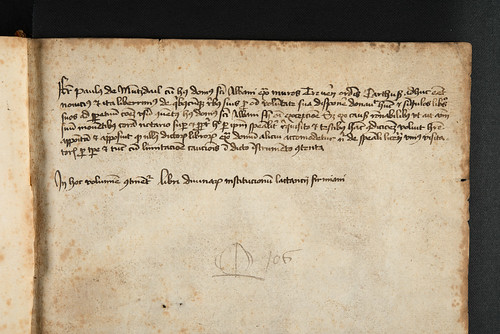Lactantius, Lucius Coelius Firmianus: Opera.
Add: Antonius Raudensis: Errata Lactantii. Venantius Honorius Clementianus Fortunatus: De resurrectione Christi carmen. Adam Montaltus: Carmen fratrem Antonium increpans.
Venice: Andreas de Paltasichis and Boninus de Boninis, de Ragusia, 12 Mar. 147[9].
Fol. a10 b-d8 e10 f-m8 M8 N6 n-r8 ſ-t6 u-x8 y6 z8 &8 ꝝ10. [214] leaves (a1, ꝝ10 blank).
ISTC il00008000; GW M16561; Goff L8; BMC V 251 (IB. 20616); Bod-inc L-010; CIBN L-9; BSB-Ink L-8.
The colophon date reads: “Hoc opus impreſſerunt Veneciis Magiſter Andreas de paltaſichis catarenſis & Boninus de boninis ſocii: Regnante inclito ac ſereniſſimo principe domino Ioanne mocenigo dei gratia Venetiarum duce .M.CCCC.LXXVIII. xii. marcii.”. As Mocenigo did not become Doge until 18 May 1478, there must be an error in the date as printed; BMC suggests that an “I” has dropped out at the end of “LXXVIII”.
| GIP number: | L6 |
| Shelf-mark: | Sp Coll Hunterian Be.2.19 (see main library entry for this item) |
| Variant: | ꝝ9r, line 20: “... impreſſerunt ...” as BMC, not “... imprſſeerunt ...” as Bod-inc. |
| Provenance: | Frater Paulus de Muntzdail (d. 1487), Doctor of Canon Law, provost of the church of the BVM in Flonheim, rector of the parish church in Kreuznach near Mainz, entered the Carthusian monastery of S. Albanus near Trier: inscription on a1r “Fr[ater] paul[us] de Mu[n]tzdail cu[m] h[uius] dom[us] s[an]c[t]i Albani ex[tra] muros Treue[renses] ord[in]is Carthu[siensis] adhuc esset noviti[us] et ita liberrim[us] de q[ui]b[us]cu[m]q[ue] r[e]bus suis p[ro] o[mn]i volu[n]tate sua dispone[re] donau[i]t hu[n]c et si[n]gulos lib[r]os suos ad p[er]petuu[m] co[mmun]e[m] vsu[m] [con]ue[n]t[us] h[uius] dom[us] s[an]c[t]i Albani s[ine] o[mn]i exceptio[n]e ... In hoc volumi[n]e [con]tine[n]t[ur] libri diuinar[um] institutionu[m] lactantij firmiani”. Trier, North Rhine-Westphalia, Carthusians, S. Albanus: see above. Trier, North Rhine-Westphalia, Augustinians, S. Germanus: inscription on a2r "Bibliothecae Trevirensis Ad. S. Germanu[m]". Edward Harley (1689-1741), Lord Harley; from 1724 2nd Earl of Oxford: see below. Thomas Osborne (d. 1767), bookseller: purchased all the Harleian printed books; top corner of first front flyleaf cut off - as in many other Harleian volumes - probably by Osborne to remove his earlier price (cf. J.B. Oldham, Shrewsbury School bindings, p.114); revised price in pencil “1-10-0” adjacent to excision; no. 793 in Osborne’s Catalogus bibliothecae Harleianae, vol. 3 (London: 1744) and no. 692 in Osborne’s Catalogus bibliothecae Harleianae, vol. 5 (London: 1745). William Hunter (1718-1783), physician and anatomist: source unknown. University of Glasgow: Hunterian bequest 1807; Hunterian Museum bookplate on front pastedown, with former shelfmark “Au.1.11”. |
| Binding: | England, 18th-century gold-tooled red sheep, bound for Lord Harley by Christopher Chapman. On both covers triple fillets form two concentric frames: within the outer frame is a floral roll (Nixon, ‘Harleian bindings’, pl. 13), and within the inner frame is an ornamental roll (Nixon, ‘Harleian bindings, pl. 14, Chapman roll 1). Both covers have a lozenge-shaped centre-piece, made up of several individual tools including Nixon ‘Harleian bindings’, pl. 15, Chapman nos 5, 8, 14a, and 14b. The head and foot of the spine are decorated with Nixon ‘Harleian bindings’, pl. 14, Chapman roll 2; the tools used in the spine compartments are not illustrated in Nixon, ‘Harleian bindings’, pl. 15; the edges and turn-ins are decorated with Chapman roll 3. Marbled endpapers; flyleaves have a watermark of a fleur-de-lys within a shield surmounted by a crown and with the ligature letters “W R” suspended below the shield, and countermark “I V”. Size: 322 x 215 mm. |
| Leaf size: | 309 x 207 mm. |
| Annotations: | Frequent 16th-century marginal notes, underlining, nota marks and manicules in quires a-f, spasmodically thereafter; the seven books of the De divinis institutionibus are numbered “1”-“7” in the top outer corner of recto leaves; 16th-century shelfmark or inventory number “M106” in ink on a1r. |
| Decoration: | Initials supplied throughout in red, many with reserved white and many with marginal flourishes; capital strokes, paragraph marks, underlining of chapter headings in red throughout. |
| Imperfections: | None. |





